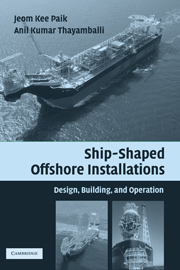Book contents
- Frontmatter
- Contents
- Preface
- Acknowledgments
- How to Use This Book
- 1 Overview of Ship-Shaped Offshore Installations
- 2 Front-End Engineering
- 3 Design Principles, Criteria, and Regulations
- 4 Environmental Phenomena and Application to Design
- 5 Serviceability Limit-State Design
- 6 Ultimate Limit-State Design
- 7 Fatigue Limit-State Design
- 8 Accidental Limit-State Design
- 9 Topsides, Mooring, and Export Facilities Design
- 10 Corrosion Assessment and Management
- 11 Inspection and Maintenance
- 12 Tanker Conversion and Decommissioning
- 13 Risk Assessment and Management
- Appendix 1 Terms and Definitions
- Appendix 2 Scale Definitions of Winds, Waves, and Swells
- Appendix 3 Probability of Sea States at Various Ocean Regions
- Appendix 4 Scaling Laws for Physical Model Testing
- Appendix 5 Wind-Tunnel Test Requirements
- Appendix 6 List of Selected Industry Standards
- Index
- References
12 - Tanker Conversion and Decommissioning
Published online by Cambridge University Press: 17 September 2009
- Frontmatter
- Contents
- Preface
- Acknowledgments
- How to Use This Book
- 1 Overview of Ship-Shaped Offshore Installations
- 2 Front-End Engineering
- 3 Design Principles, Criteria, and Regulations
- 4 Environmental Phenomena and Application to Design
- 5 Serviceability Limit-State Design
- 6 Ultimate Limit-State Design
- 7 Fatigue Limit-State Design
- 8 Accidental Limit-State Design
- 9 Topsides, Mooring, and Export Facilities Design
- 10 Corrosion Assessment and Management
- 11 Inspection and Maintenance
- 12 Tanker Conversion and Decommissioning
- 13 Risk Assessment and Management
- Appendix 1 Terms and Definitions
- Appendix 2 Scale Definitions of Winds, Waves, and Swells
- Appendix 3 Probability of Sea States at Various Ocean Regions
- Appendix 4 Scaling Laws for Physical Model Testing
- Appendix 5 Wind-Tunnel Test Requirements
- Appendix 6 List of Selected Industry Standards
- Index
- References
Summary
Introduction
For offshore oil and gas production, storage, and offloading, particularly in marginal fields, existing tankers are often converted to ship-shaped offshore units instead of using a new-build option. In fact, more than two thirds of all such ship-shaped offshore installations worldwide are currently thought to be built from converted tankers. More recent practice indicates that the application of converted offshore structures is more common in relatively benign environments, although a new-build installation may be more appropriate for special purposes in harsh conditions and/or for longer term use (e.g., more than 10–15 years). These are general statements, and operations using conversions have also been considered for fields with harsh environmental conditions as well. In marginal fields, it is often the relative cost advantage and better ability to fast track that makes a conversion more compelling than a new build. The number of vessels potentially available for conversions, however, have continued to dwindle over time.
In Section 1.6 of Chapter 1, the many advantages and disadvantages of the conversion option for ship-shaped offshore installations were discussed. The possible advantages include reduced capital costs, a less expensive and fast-track design and construction schedule, increased choices regarding construction facilities, and perhaps reduced overall project supervision requirements (Parker 1999). The disadvantages may include shorter design and remaining lives; greater site-specific environment limitations; perhaps increased operating costs because of difficulty in building in high safety factors; reduced or minimal resale and residual values; reduced reusability opportunities; and the relatively greater need for increased risk-mitigation measures related to regulatory compliance, which, as expected, have increased over time.
Information
- Type
- Chapter
- Information
- Ship-Shaped Offshore InstallationsDesign, Building, and Operation, pp. 447 - 462Publisher: Cambridge University PressPrint publication year: 2007
